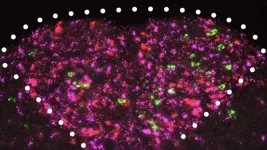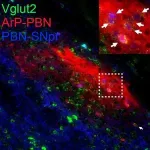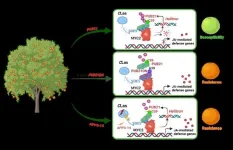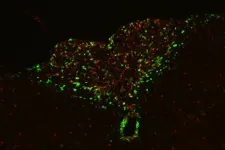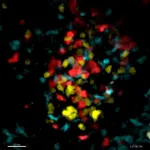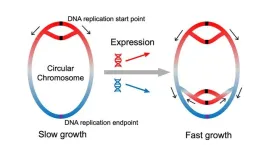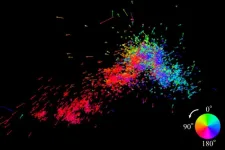(Press-News.org) Cancer ravages both body and mind. If you’ve ever lost loved ones to the disease, you might recognize the physical and emotional changes cancer patients often endure during their final months. They seem drained of strength and spirit. Even people who’ve maintained a positive outlook throughout their lives can enter a state of despair. New research published in Science suggests apathy and lack of motivation are symptoms of a condition called cancer cachexia. Cold Spring Harbor Laboratory (CSHL) Associate Professor Tobias Janowitz explains:
“Many patients complain of symptoms in that category. They say, ‘I don’t know what’s going on with me. My relatives cooked my favorite meal. I don’t feel like eating it.’ Their grandchildren come for a playdate. Usually, they’d be excited and enjoy it. They just don’t seem to engage so much.”
Also frustrating, cachexia severely limits patients’ ability to tolerate common cancer treatments. CSHL scientists have been studying the condition for years. Now, in a major development, Janowitz and colleague Adam Kepecs at Washington University School of Medicine in St. Louis (WashU Medicine) have identified a connection between the brain and the immune system that is responsible for cachexia-related apathy.
They found that as cachexia progresses, certain neurons release less and less dopamine. That’s the brain’s “feel-good” chemical. Screening for elevated immune system proteins in the brains and bodies of mice with cachexia led the team to IL-6, which gets released during inflammation and has long been associated with cachexia. Decreasing IL-6 signals in connected brain areas made the mice more motivated. Notably, the mice became less sensitive to the amount of effort required to find food. The scientists saw the same result when elevating dopamine levels in the right brain areas.
“We discovered a full brain circuit that senses inflammation in the bloodstream and sends signals that reduce motivation,” Kepecs says. “This reveals that apathy isn’t just an emotional or psychological reaction to cachexia—it’s built into the biology of the disease.”
The discovery further suggests that existing antibody treatments could be repurposed to improve cancer patients’ quality of life. “Our goals are to make patients feel better and to treat the cancer better,” Janowitz explains.
“A better patient will be able to better tolerate and benefit from anti-cancer treatments.”
Working across cancer and neuroscience has brought the researchers this far. Their ultimate hope is that one day, through continued interdisciplinary collaboration, they will help turn cachexia into a condition patients can overcome. That would be a welcome development not only for people battling cancer but also for their loved ones who suffer alongside them.
END
It’s not you—it’s cancer
2025-04-10
ELSE PRESS RELEASES FROM THIS DATE:
Drug pollution alters migration behavior in salmon
2025-04-10
In the largest study of its kind to date, a team of international researchers has investigated how pharmaceutical pollution affects the behaviour and migration of Atlantic salmon.
The study, led by the Swedish University of Agricultural Sciences, revealed that commonly detected environmental levels of clobazam – a medication often prescribed for sleep disorders – increased the river-to-sea migration success of juvenile salmon in the wild.
The researchers also discovered that clobazam shortened the time it took for juvenile salmon to navigate through two hydropower dams along their migration route – obstacles that typically ...
Scientists decode citrus greening resistance and develop AI-assisted treatment
2025-04-10
In a groundbreaking study published in Science, a research team led by Prof. YE Jian from the Institute of Microbiology of the Chinese Academy of Sciences has identified the first mechanism of citrus resistance to citrus greening disease, or huanglongbing (HLB).
Utilizing artificial intelligence (AI), the team has also developed antimicrobial peptides that offer a promising therapeutic approach to combat the disease. This discovery addresses a long-standing challenge in the agricultural community—the absence of naturally occurring HLB-resistant genes in citrus.
Citrus ...
Venom characteristics of a deadly snake can be predicted from local climate
2025-04-10
Local climate can be used to predict the venom characteristics of a deadly snake that is widespread in India, helping clinicians to provide targeted therapies for snake bite victims, according to a study publishing April 10 in the open-access journal PLOS Neglected Tropical Diseases by Kartik Sunagar and colleagues at the Indian Institute of Science.
Russell’s viper (Daboia russelii) is found across the Indian subcontinent and is responsible for over 40% of snake ...
Brain pathway links inflammation to loss of motivation, energy in advanced cancer
2025-04-10
The fatigue and lack of motivation that many cancer patients experience near the end of life have been seen as the unavoidable consequences of their declining physical health and extreme weight loss. But new research from Washington University School of Medicine in St. Louis challenges that long-held assumption, showing instead that these behavioral changes stem from specific inflammation-sensing neurons in the brain.
In a study published April 11 in Science, the researchers report that they identified a direct connection between cancer-related inflammation ...
Researchers discover large dormant virus can be reactivated in model green alga
2025-04-10
Researchers had been studying the green alga Chlamydomonas reinhardtii for decades without seeing evidence of an active virus within it — until a pair of Virginia Tech researchers waded into the conversation.
Maria Paula Erazo-Garcia and Frank Aylward not only found a virus in the alga but discovered the largest one ever recorded with a latent infection cycle, meaning it goes dormant in the host before being reactivated to cause disease.
“We’ve known about latent infections for a long time,” said Aylward, associate professor in the Department of Biological Sciences. ...
New phase of the immune response uncovered
2025-04-10
The research groups led by Wolfgang Kastenmüller and Georg Gasteiger employed innovative microscopy techniques to observe how specific immune cells, known as T-cells, are activated and proliferate during a viral infection. Their findings revealed novel mechanisms: the immune system amplifies its defense cells in a far more targeted way than previously believed.
T-Cells Proliferate and Specialize During the Immune Response
T-cells are crucial defense cells in the immune system. To effectively ...
Drawing board rather than salt shaker
2025-04-10
Bioinformaticians from Heinrich Heine University Düsseldorf (HHU) and the university in Linköping (Sweden) have established that the genes in bacterial genomes are arranged in a meaningful order. In the renowned scientific journal Science, they describe that the genes are arranged by function: If they become increasingly important at faster growth, they are located near the origin of DNA replication. Accordingly, their position influences how their activity changes with the growth rate.
Are genes distributed randomly along the bacterial chromosome, as if scattered from a salt shaker? This opinion, which is held by a majority of researchers, has ...
Engineering invites submissions on AI for engineering
2025-04-10
Artificial intelligence (AI) is playing an increasingly pivotal role in revolutionizing the field of engineering, triggering a new era of technological and industrial evolution. A series of recent breakthroughs in areas like natural language processing, computer vision, and machine learning, with the Nobel Prize-winning work in artificial neural networks and protein structure prediction serving as prime examples, have effectively bridged the gap between the physical and digital worlds. The emergence of general AI technologies, especially large language models, has given rise ...
In Croatia’s freshwater lakes, selfish bacteria hoard nutrients
2025-04-10
Bacteria play key roles in degrading organic matter, both in the soil and in aquatic ecosystems. While most bacteria digest large molecules externally, allowing other community members to share and scavenge, some bacteria selfishly take up entire molecules before digesting them internally. In a paper publishing April 10 in the Cell Press journal Cell Reports, researchers document “selfish polysaccharide uptake” in freshwater ecosystems for the first time. In Croatia’s Kozjak and Crniševo Lakes, they found that nutrient hoarding allows selfish species ...
Research suggests our closest neighboring galaxy may be being torn apart
2025-04-10
A team led by Satoya Nakano and Kengo Tachihara at Nagoya University in Japan has revealed new insights into the motion of massive stars in the Small Magellanic Cloud (SMC), a small galaxy neighboring the Milky Way. Their findings suggest that the gravitational pull of the Large Magellanic Cloud (LMC), the SMC’s larger companion, may be tearing the smaller one apart. This discovery reveals a new pattern in the motion of these stars that could transform our understanding of galaxy evolution and interactions. The results were published ...
